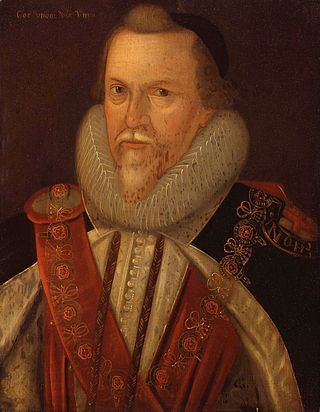
Edward Somerset, 4th Earl of Worcester, KG, Earl Marshal was an English aristocrat. He was an important advisor to King James I, serving as Lord Privy Seal.

Thomas Cecil, 1st Earl of Exeter, KG, known as Lord Burghley from 1598 to 1605, was an English politician, courtier and soldier.

Henry Howard, 1st Earl of Northampton was an important English aristocrat and courtier. He was suspected throughout his life of being Roman Catholic, and went through periods of royal disfavour, in which his reputation suffered greatly. He was distinguished for learning, artistic culture and his public charities. He built Northumberland House in London and superintended the construction of the fine house of Audley End. He founded and planned several hospitals. Francis Bacon included three of his sayings in his Apophthegms, and chose him as "the learnedest councillor in the kingdom to present to the king his Advancement of Learning." After his death, it was discovered that he had been involved in the murder of Sir Thomas Overbury.
William Cecil, 16th Baron Ros of Helmsley was an English peer, whose ill-advised marriage to Anne Lake resulted in a major scandal, which dragged on for years after his early death.

Francis Manners, 6th Earl of Rutland, KG (1578–1632) was an English nobleman. Despite a brief imprisonment for his involvement in the Essex Rebellion of 1601, he became prominent at the court of James I. He lived at Belvoir Castle in Leicestershire. In 1618 three women, the "Witches of Belvoir", were accused of witchcraft for having allegedly caused the deaths of his two young sons.
Elizabeth, Lady Coke, was an English court office holder. She served as lady-in-waiting to the queen consort of England, Anne of Denmark. She was the daughter of Thomas Cecil, 1st Earl of Exeter, and Dorothy Neville, and the granddaughter of William Cecil, 1st Baron Burghley. She was the wife of Sir William Hatton and later of Sir Edward Coke.

Anna Maria Talbot, Countess of Shrewsbury was Countess of Shrewsbury from 1659 to 1668, by virtue of her marriage to Francis Talbot, 11th Earl of Shrewsbury.
Elizabeth de Vere, Countess of Oxford, formerly Elizabeth Trentham, was the second wife of the Elizabethan courtier and poet Edward de Vere, 17th Earl of Oxford.
Sir Edward Rodney was an English politician who sat in the House of Commons at various times between 1621 and 1642.
Sir Henry Seymour was an English landowner and MP, the brother of Jane Seymour, queen consort of Henry VIII, and consequently uncle to Edward VI. He was created a Knight of the Bath after his nephew's coronation.
Sir Robert Southwell (1563–1598), of Woodrising, Norfolk, was an English politician.
Barbara Ruthven was a Scottish courtier and favourite of Anne of Denmark, expelled from court after the death of her brother.
Sir Ambrose Turvile, (1581-1628), Courtier and cupbearer to Anne of Denmark.
Mary Gargrave was a courtier to Anne of Denmark.

Elizabeth Howard (1564—1646) was an English aristocrat and courtier to Elizabeth I of England.
Elizabeth Moleyns was an English courtier.
Katherine Southwell was an English courtier.

Anne Keilway, Lady Harington was an English courtier.
Margery Lyster or Lister, nee Horsman was an English courtier. She is known as a member of the households of three queens of England; Catherine of Aragon, Anne Boleyn and Jane Seymour.

Anne Lake Cecil, Lady Roos or de Ros (1599–1630) was an English aristocrat involved in a major scandal at the Jacobean court.








